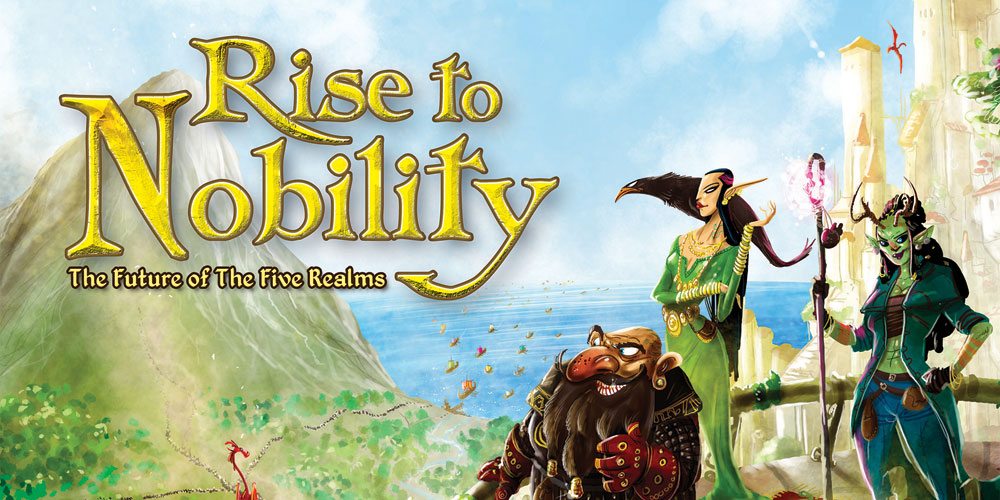The High Queen Tabitha Orestes is building a new city, the capital of the Five Realms, and you just happen to own some suddenly valuable property. Build houses for the incoming settlers and help them find jobs, get some people placed into the right guilds, and you just might earn yourself a spot on the Stone Council. Will you be able to Rise to Nobility?
At a glance: Rise to Nobility is a dice-and-worker-placement game from Final Frontier Games for 2 to 5 players, ages 14 and up, and takes about 25 minutes per player. It’s currently seeking funding on Kickstarter, with a pledge of $49 for a copy of the game. (There are also pledge levels for access to the Print and Play, or a deluxe version that has custom laser-engraved dice and fancier resource tokens.) The game is fairly involved, so I think the 14 and up is about right; younger players who have the patience for a lot of rules and longer games may be okay, since there’s nothing thematically inappropriate in the game.
New to Kickstarter? Check out our crowdfunding primer, and visit our curated page for more projects we love.
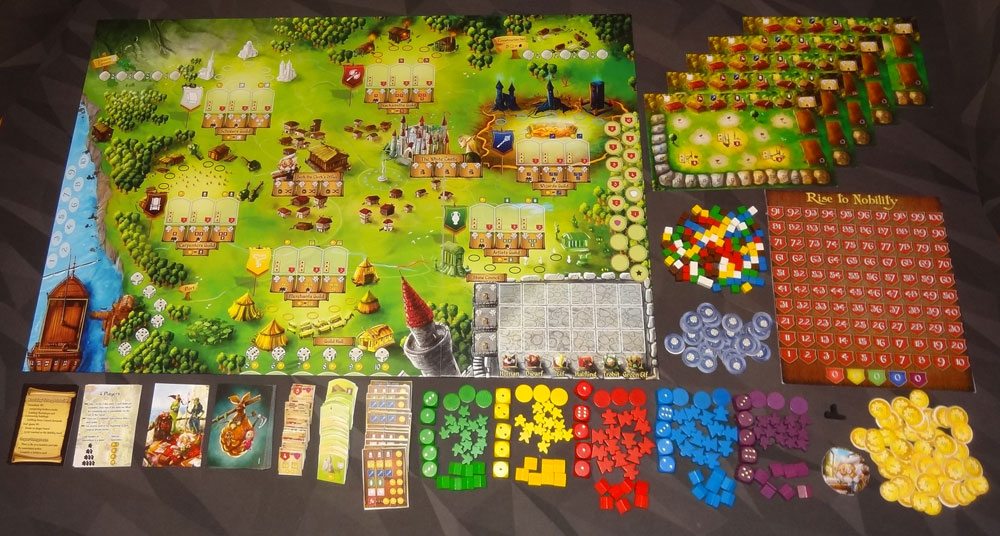
Components
- Game Board
- Victory Point track
- 5 Player boards
- 5 Character cards
- Player components:
- 5 Dice
- 7 Houses
- 14 Meeples
- 1 Reputation marker
- 1 Score marker
- 1 Nobility marker
- 48 Settlers Cards
- 36 Building tiles (12 Community Buildings, 4 each of the Guild Workshops)
- 12 Ship tiles
- 30 Stone Council tiles
- 120 Goods cubes (20 each in six types: Weaponry, Artwork, Magic Items, Jewelry, Books, Furnishings)
- 50 Gold tokens
- 20 Dice Modifier tokens
- 1 Starting Player token
- 1 Round marker
Note: since my review is based on a pre-production prototype, components are subject to change, and final component quality will be better than what is pictured here. There is some completed artwork, but final layout and icons may be tweaked.
The artwork for the game is by The Mico, whose artwork has been showing up in a lot of different places, including the Valeria line of games. This game is a sequel to Cavern Tavern, so keeping the same artist also helps tie these two games together thematically, and the board looks really fantastic—it’s the map of the region, with various spaces where you can place dice and send your new settlers.
I can’t say much about the components themselves since I don’t know what the final wooden pieces will be like, but everyone will have some little houses, meeples, dice, and a few markers for tracking score, nobility, and other things. As you can see from the photo above, though, it’s a fairly large board, and everything is very colorful and visually striking. When I played this at a local gaming convention, I had a lot of people stopping to admire it and see what it was. But that does mean it takes up a good deal of table space, too, so be prepared for that!

How to Play
The goal of the game is to have the most victory points after 10 rounds of play.
To set up, you give each player a player board and the player components in their color. The score marker is placed at the start of the scoring track, the nobility marker is placed at the start of the nobility track on the main game board, and the reputation marker is placed on the “9” on the player’s own board. The player puts 1 house on their construction platform on their board. The rest of the houses and meeples are set aside in the supply for now. Every player also gets 8 gold, one randomly dealt character card, and one randomly dealt Settler card with a “1” on the back.
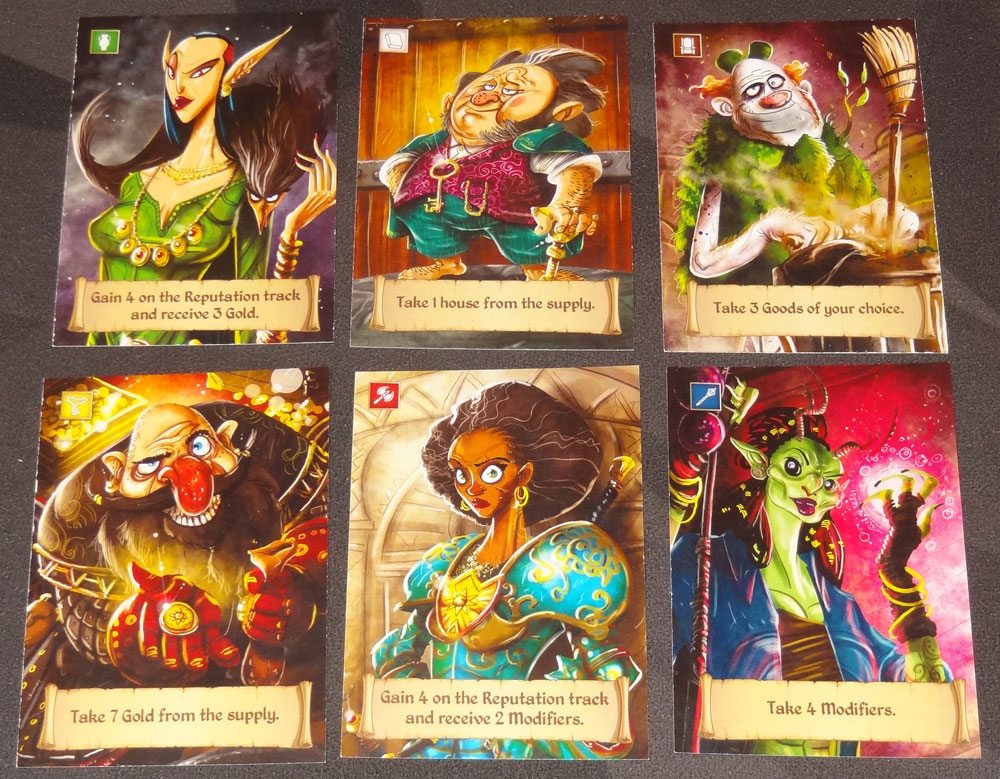
Shuffle the various cards and tiles. (For the Settlers deck, once everyone has received a card from deck 1, the deck 1 and deck 2 cards can be shuffled together into one pile.) One ship tile is placed on the ship space on the board. 6 Settler cards are turned face-up next to the Cavern Tavern location. 6 building tiles are placed below the Guild Hall in the available spaces. The Stone Council spaces are filled randomly with the Council tiles. For a 2-player game, there will also be some workshops placed in the various guilds.

During the game, you will be placing dice onto the board to take particular actions, and these spaces require particular values of dice to activate. However, your total limit for placing dice is equal to your reputation, so early in the game you’re rather limited, and building up your reputation (usually at the White Castle) will give you the ability to take more actions. Without getting into too much detail about each space, here’s a quick run-down of the types of spaces:
- The White Castle: Increase your reputation.
- Berk the Clerk’s Office: Pick up +1/-1 tokens that let you modify dice, and also refresh the Cavern Tavern or Guild Hall.
- Cavern Tavern: Welcome a family to town by taking a Settlers card from the Cavern Tavern area.
- Construction Yard: Buy a house for 5 coins so those new settlers have somewhere to live.
- 6 Guilds: Each guild has spaces where you can buy a particular resource, as well as spaces for workers to become apprentices.
- Guild Hall: Build a workshop in a guild or a community building on your board.
- Port: Sell resources to the ship for money.
- Stone Council: Trade resources and gold for points.
On each turn, you must place a die on a space, and you may optionally complete a Settlers card (before or after placing a die). Generally, you need specific die values for each space—many of the locations have three spots: 1/2, 3/4, and 5/6, though the number of spaces available is limited based on player count. At the Cavern Tavern, each subsequent die must be greater than or equal to the dice before; at the Construction Yard, it’s the opposite. Higher values let you purchase more resources from the guilds, but lower numbers let you place workers as apprentices after you make your purchase.
The White Castle and Berk the Clerk’s Office both help with dice placement. At the White Castle, you spend some time buttering up the Queen, and your reputation goes up—the higher the die, the more reputation you get. At Berk the Clerk’s Office, you can pick up modifier tokens that can be spent to increase or decrease a die. The higher the die spent, the more tokens you get. You may also refresh either the Settlers cards at the Cavern Tavern or the buildings at the Guild Hall if you want to see a fresh set.
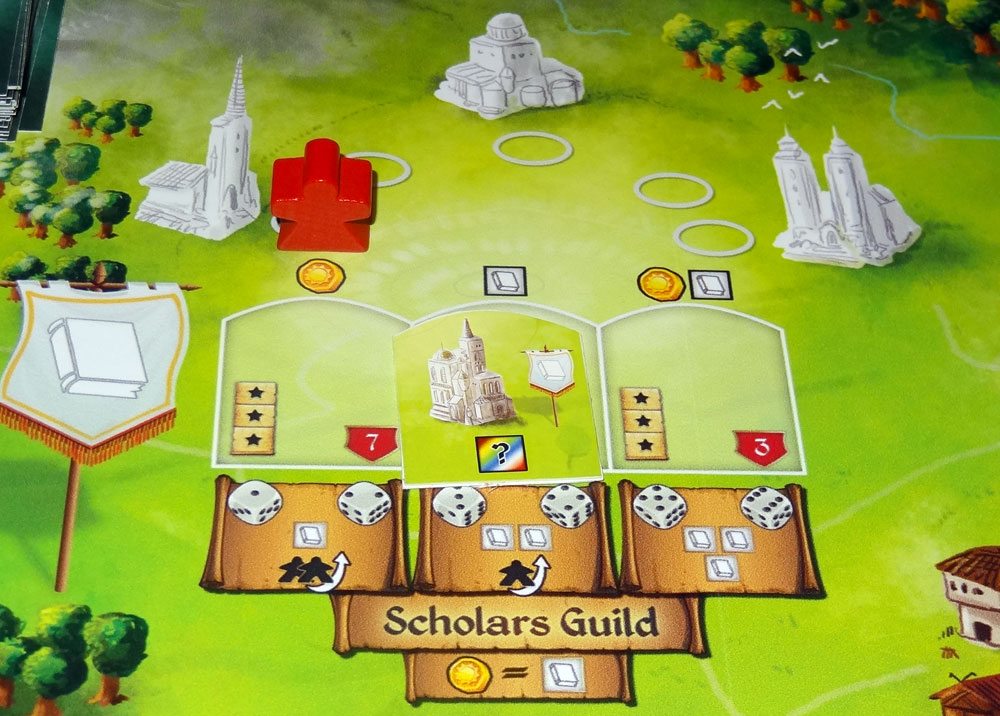
To complete a Settlers card, you must have a house available and be able to furnish it with the various things the family likes. So let’s go shopping! You get resources by visiting the Guilds—each one specializes in a particular resource. The higher the die value you place, the more resources you may buy (at 1 coin per resource). There may be some bonuses based on the workshops there, but that’s the basic idea.
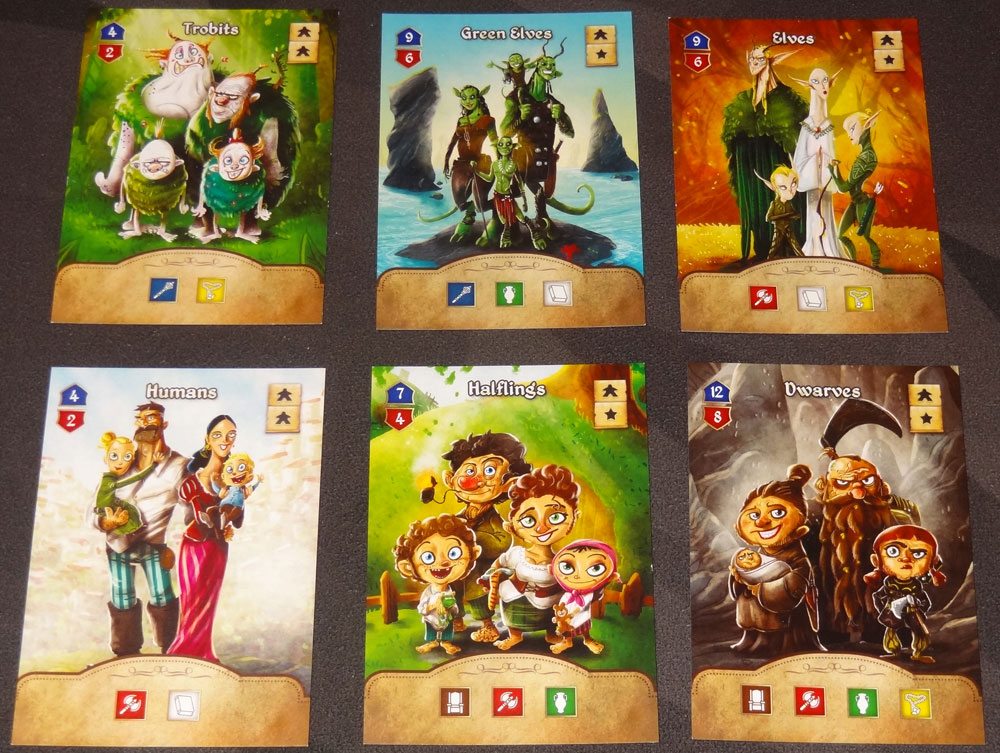
Each Settler card has a range that they’re willing to “spend” on their house (which translates to victory points). You must spend that many resource cubes, but there are some restrictions: you may only spend resources of the type they asked for, you must spend at least one of each of those resources, and you may only spend up to 3 of any given type. Your character card has one resource pictured in the top corner, which lets you spend up to 4 of that sort if it’s one of the required types.

You turn in all the required resources to the supply, move your house from your construction platform to one of the building sites on your player board, and then get points equal to the number of cubes you spent. Each Settler card also has pictured either two meeples or a meeple and a star. You get meeples (placed on your player board) and move up the nobility track if there’s a star. Congratulations! You’ve just found a home for this family.
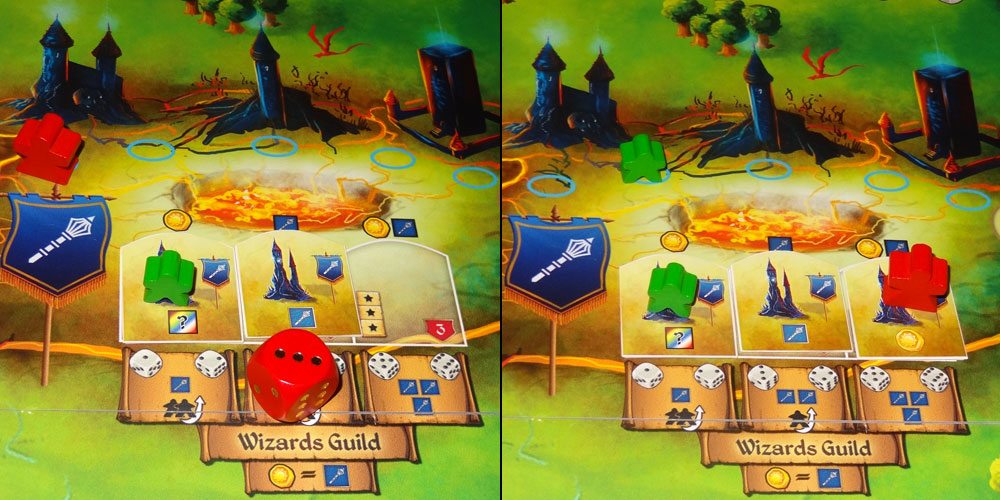
Of course, now the family needs work—that’s where the apprentice slots come in. Each guild has a number of apprentice slots (equal to the number of players), and whenever you place a die of value 1 to 4 in that guild, you also have the opportunity to move 1 or 2 workers into the apprentice slots at that guild, either from other guilds or from your player board. Each apprentice at a guild will give you 1 free resource of that type when you purchase at least 1, plus each apprentice will earn you income at the end of the round. However, the income per apprentice decreases as the number of apprentices goes up.
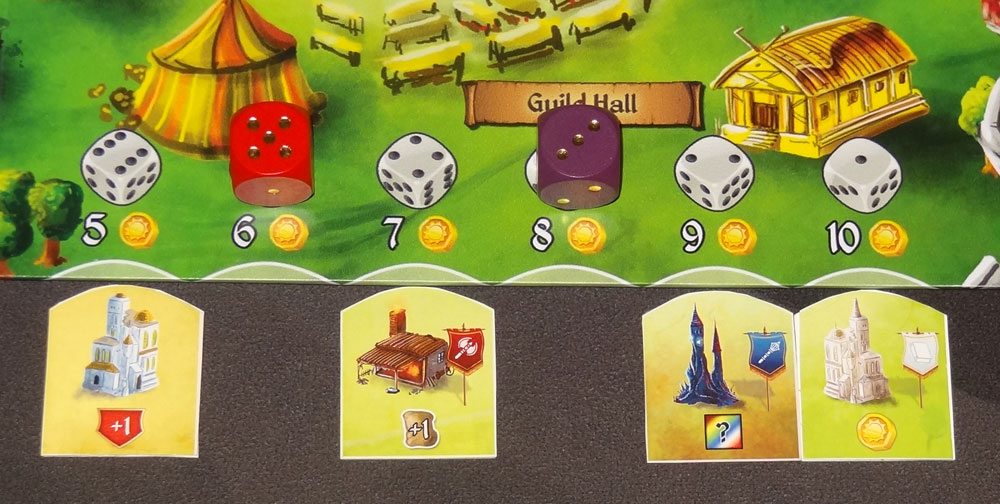
The other benefit of having an apprentice is that you can then build a workshop in that guild–you place a die in the Guild Hall and spend the appropriate amount of money, and then the workshop goes into left-most available space in the guild. Your apprentice becomes a guild master (place it on the workshop). You get an immediate benefit of points and nobility. Each workshop also gives bonuses for players who visit the guild, and you get a bonus when other players visit the guild as well. The one downside, though, is that you no longer get the free resources and end-of-round income from your apprentice.

At the Guild Hall, you can also build Community Buildings, which go onto your player board. There are three spaces for these on your player board, and when you build them you immediately get some points and nobility, but each Community Building adds 1 to your score whenever you complete a Settlers card.

Short on money? Sell resources at the port. The die you place determines how many goods you may sell, and you place those goods onto the available spaces of the ship, taking coins as shown. The ship will be cleared off and replaced each round, so sometimes you want to wait to get a better price for your goods.
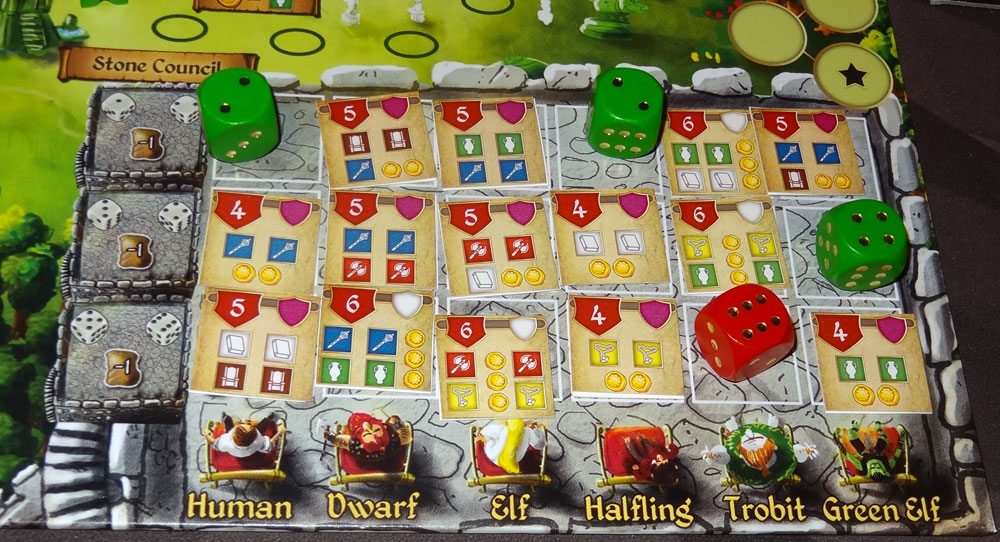
As you earn nobility, you’ll eventually encounter a purple shield and a white shield on the nobility track. When you reach the purple shield, you immediately get the bonus shown at the bottom of your character card, and then you flip your card over. You no longer get the resource bonus for completing Settlers cards, but it also gains you entrance to the Stone Council, where the heads of the various realms are vying to protect their own interests. At the Stone Council, you may only interact with a leader if you have settled a family of that race already, and if you have reached the nobility level required by the particular tile. (Some have purple shields, and some have white shields.) Hand over the resources and/or gold, and you get points. However, the Queen doesn’t like it when you show favoritism to a particular realm, so whenever you visit the Stone Council, your reputation goes down.
At the end of the round—once everyone has passed because they cannot (or choose not to) play any more dice—everyone earns income from their apprentices, and then retrieves all of their dice. The ship is cleared and replaced with a new ship, the Guild Hall buildings are moved to the left to fill in empty spaces and refilled, and the Stone Council tiles are refilled. First player token passes to the left, and a new round begins.
The game ends after 10 rounds. You then add victory points based on your location on the nobility track, plus 1 point for every 2 resources remaining on your player board. The highest score wins, with ties going to the player with the most houses, and then the most nobility, and then the most gold.
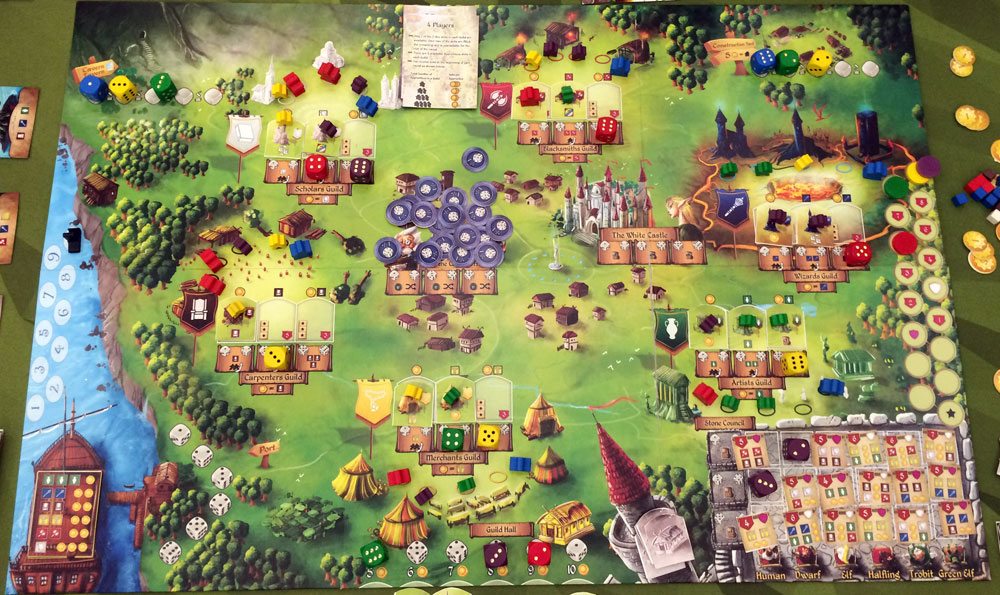
The Verdict
There’s actually a story that connects Cavern Tavern to Rise to Nobility—my prototype copy of the game actually came with a little advance reader copy of a novella called The Secret of the Five Realms, which is one of the add-ons in the campaign (or included in the deluxe tier). The writing was a little rough (it hadn’t gotten proper editing yet) but the story was fun, and tells the story of how Nasty the Dwarf came to run the Cavern Tavern, why it’s staffed by former mercenaries, and how Queen Tabitha Orestes established the city of Caveborn. It also explains why you just happen to own some valuable property in town, perfect for building houses for all of those incoming settlers.
Like Cavern Tavern, Rise to Nobility is a dice-based worker-placement game, but it’s a bit heavier and has a steeper learning curve. There are more types of spaces to place dice, reputation to manage, and an interesting trade-off between apprentices and guild masters. Generally you’ll be trying to bring in new settlers early in the game, because those give you workers, who can then become apprentices and earn income for you. As you progress and settle more families, you’ll want to promote those workers to become guild masters, losing the income but gaining points and nobility. Guild masters also make that guild more rewarding for everyone who visits it, but you get a bonus when other players go there. Finally, if you manage to build up your economy so that you have plenty of extra resources and money, it may be worth the dip in reputation to visit the Stone Council to earn some more points before the game ends.
The apprentices are very useful both because they get you free resources and because they earn you income at the end of the round—but they don’t earn as much when other apprentices join you there. It makes for an interesting balance as players jockey for position, hoping that somebody else will leave so their own apprentices will make more money.
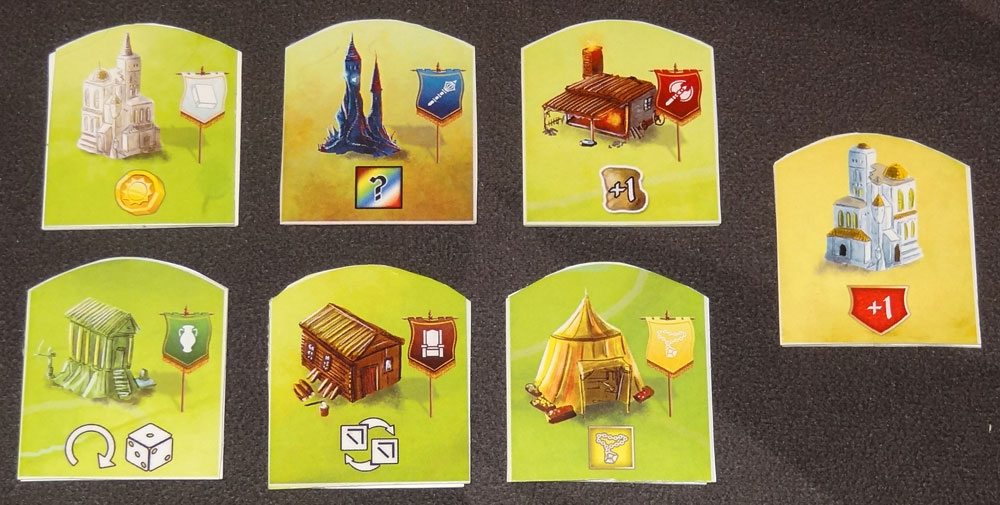
The various workshops available have a lot of different abilities, but how many of those you’ll see in play in a given game depends on how many get purchased or how often the Guild Hall is refreshed using the power from Berk the Clerk’s Office. The various bonuses include resources, coins, reputation, dice re-rolls, and trading resources for other types. Each guild has a different mix of four of these abilities, though there’s a lot of overlap. As workshops are built, the various guilds become more differentiated, because at the beginning of the game they’re mostly equivalent—you can buy resources and assign apprentices for income. But later in the game, you might take a chance at a workshop that lets you re-roll a die, or visit the “extra wild resource” workshop so you can acquire two different types of goods with one die.
As with most worker-placement games, a lot of the interaction with other players in this game comes in the form of taking the spaces that somebody else wants to use. If somebody really wants jewelry for their settlers and you take the space before they do, they’ll have to find other ways to acquire it, or find something else to do until the next round. At the Cavern Tavern and the Construction Yard, where dice have to increase or decrease (respectively), you can make things much more difficult depending on what numbers you place.
The game did seem a bit busy to some of my players—that is, that there were a whole lot of different options available on your turn, but additional choices don’t always mean a better game. I think that will be a personal preference: if you like games where there are several different directions to go at any given time, then Rise to Nobility offers that. However, if your group is prone to analysis paralysis, then this game might not be the best choice for you.
The theme and artwork go well together. While I don’t think you really need to read the novella to appreciate the game, it was fun to know the backstory and I think that added some value to the game for me. (Although I do hope there’s some serious editing on the book before the final publication!) I like the flow of bringing in these new settlers, building them homes and furnishing them, and then finding them jobs in the various guilds around the city.
Overall, Rise to Nobility is an intriguing game with a fantastic theme that combines dice placement and worker placement; the tension between managing your reputation, pursuing nobility, and scoring points is challenging and engaging. If you enjoyed Cavern Tavern and you’re looking for a step up in complexity and weight of the strategy, visit the Rise to Nobility Kickstarter page and check it out!
